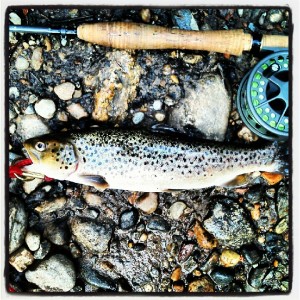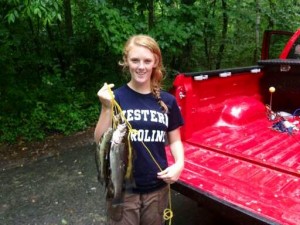If ever you’re bored and wanting to find an outdoor activity, I suggest looking up local fishing shops and learning what you can about trout fishing. With the Tuckasegee, a heavily stocked delayed harvest water, so close to home, it’s almost too tempting to pass up.
According to the NC Wildlife Resources Commission (NCWRC), the NCWRC stocks about 6 million fish in public lakes, ponds, streams and rivers each year. The fish are raised at hatcheries in various places across the state. There are four coldwater NCWRC hatcheries and one coolwater NCWRC hatchery in Western North Carolina. According to the NCWRC Hatcheries website, the Armstrong Hatchery and Marion Hatchery in McDowell County and Bobby N. Setzer Hatchery in Transylvania County raise more than a half million brook, brown and rainbow trout annually. It is imperative for the hatcheries to stock the fish to maintain the populations. Many factors go into choosing fish for stocking and can be searched further on the NC Wildlife website. The brook trout is the only native species in WNC.
Over the summer I went trout fishing for the first time in Mills River, North Carolina just over the eastern hill from WCU. The day started out grim and gray, like most days over the 2013 rainy summer in Western North Carolina. Ominous clouds hung overhead and distant thunder rang faintly in the distance. Matt Bodenhamer and I pulled up on the side of the road in a spot hardly big enough for Matt’s big red truck to be off the blacktop. He was taking me to his secret “honey hole”.
“No one is ever willing to travel as far as we went,” Matt said. “I found that spot a few years ago with my dad and have been going there ever since.”
Matt and I were fishing in North Mills River, which is hatchery supported trout water during delayed harvest. During delayed harvest, which will open at 12 p.m. on June 7 in 2014, anglers can harvest seven fish per fisherman per day using whatever bait they choose.
“During delayed harvest, you’re allowed to use any type of bait, single or treble hooked, natural or artificial baits. When it’s not delayed harvest its single hook, artificial bait only and you cannot keep the fish,” Matt explained.
During other times and on different types of rivers, other stipulations apply. There are quite a few regulations on mountain trout fishing. Public fishing sites around the area include catch and release/ artificial flies only trout waters, catch and release/artificial lures only trout waters, delayed harvest trout waters, hatchery supported trout waters and wild trout/natural bait waters. The NC Wildlife Resources Commission has a handy map so that you can type in your location and it will show you what types of waters are around you.
We gathered our essential supplies—fishing poles, bait, net, extra hooks. When our trip started, I was a little irritated because it was damp and chilly and we had to forge the river three times. It had rained so much that summer that the ordinarily well-kept trail was turned to nothing but mud and rivets. Matt was trucking along in his waterproof waders and knee-high boots, oblivious to the mud and the moisture I was diligently trying to maneuver around in Chacos and pants that would theoretically dry quickly. With each step we took it seemed as if the clouds hung lower in the sky, heavy under their burden of rain.

Brown trout can also be found in WNC rivers. Matt Bodenhamer caught this one while fly fishing in North Mills River. Photo Credit: Matt Bodenhamer
According an article by David Fegura on blog.syracuse.com, “Rain, rain: It’s good for the trout fishing- – sometimes”, trout fishing in the rain can be a good thing—sometimes.
“With crystal clear water, it’s difficult to stalk them. They can see you. but with a little bit of rain and some color in the water, you can get right on top of them,” said Jason Decapio, a renowned central NY trout fisherman and owner of The Wayfarer Company, in the article by Fegura.
According to Decapio, if the rain is warmer than that of the river water, it sends the fish into a feeding frenzy. Rain can also be ideal weather for trout fishing because it knocks food sources into the river such as earthworms and bugs from the banks and from trees.
It wasn’t long before Matt and I figured that out. We had hardly made it to his “honey hole” and cast a couple of times before the droplets started raising ripples on the river and then bubbles because of the force of rain hitting the water. I stood in my t-shirt, drenched from feet to knees and from head to waist, irritated because I kept getting the line and weight tangled in the tree limbs hanging over the river. Matt patiently helped me untangle the lines and demonstrated the correct way to cast. Upriver, let the bait float down a little ways, wait a few seconds, then reel it back in and try again. He went back to his spot and it wasn’t long before I heard him shout in excitement. I laid my pole down on the bank because I was tangled in the tree again and walked over to where he was.
As I made my way over to Matt, I saw that his line was taut and flashes of silver struggled below the water. He reeled in the first rainbow trout of our day. After removing the hook, he placed the fish on the stringer and I went back to my place, determined to catch a fish despite the rain and a bad attitude.
One of the most important tips about trout fishing is to have the right equipment, but it is certainly not the only challenge.
“In the man-versus-nature category of activities, fishing ranks as one of the most satisfying challenges. And trout fishing, which requires knowledge of fish habits, stream characteristics and weather patterns, may be the pinnacle of the sport. Perhaps that’s why almost 7 million Americans spend 76 million days a year on the hunt for brookies, rainbows, cutthroats and their spotted kin,” William Harris explains in an article, “Top 5 Trout Fishing Essentials”, on How Stuff Works’ website.
According to Harris, the first essential in trout fishing is the “rig”. Knowing when to use a small rig or a large rig is imperative and could be the difference in catching or not catching a fish. Smaller rivers or streams have smaller fish and therefore call for a smaller rig. Harris suggests an ultralight rig between four and five feet. For larger rivers, deeper water and larger fish, he suggests a medium to heavy action six to seven-foot rig.
Other essentials listed in Harris’ article include baits and lures, waders and boots, vests and hats and nets and creels.
I cast a few more times through the on and off rain and finally felt the bump-bump of a fish on my line. In my excitement, I set the hook harder than I should have and the rainbow trout flew out of the river towards the bank. It landed in the water about two feet from where I stood on the bank and I had to reel in the slack in the line before it darted away. Matt helped me pull the fish in and we put him on my stringer. From that moment on it was if the rainbow trout were attracted to my line. I pulled in six trout and Matt pulled in four before we were forced to leave in a hurry as all the rain had caused the river to rise very quickly. On our way out, the river was almost up to my waist where on the way in it had been only at my knees.
I was pleased to have caught one of the biggest rainbow trout Matt said he had ever seen (I named him Bernard). After drying ourselves off, we took our catch back to his house where Matt cleaned the fish.
“I first start at the throat, then sever it down the belly to the tail. Then I cut the head off, and with the head comes the entrails. I then peel it all out and then clean the rest of it by washing it in water,” Matt explained.
We then experimented with our own cooking techniques and wound up with a delightful meal, made entirely on our own.
Trout fishing was an exhilarating experience from the rain to the casting to escaping the raging river to the cleaning. It was also a great way to have a delicious meal without even having to pay for it.
Catch and release artificial fly and artificial lure waters are open year round as well as wild trout natural bait waters. However, make yourself familiar with the NCWRC regulations before heading out. For more information about regulations, visit the NC Wildlife Resources Commission’s Inland Fishing Regulations & Information document on mountain trout.
Always exercise caution when taking to the rivers and keep a mind about the rules and regulations. Always be sure to buy a NC fishing license before casting in any river or lake, as well.



